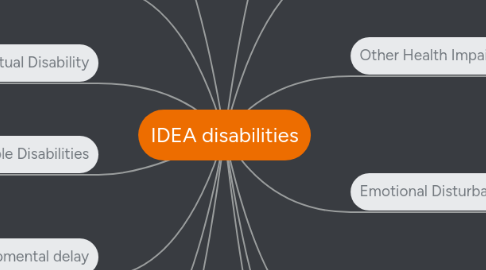
1. Austism Spectrum Disorder (ASD)
1.1. A range of behaviors affecting verbal and nonverbal communication. engaging in repetitive activities and stereotyped movements, resistance to environmental change or change in daily routines, and unusual responses to sensory experiences.
1.1.1. Sensory vests, fidgets, noise cancelling headphones, printed schedules, picture lists, use of special lighting, scribe
1.1.2. Computer usage, tex to speak program
1.2. Case Study sped.dpi.wi.gov/files/sped/doc/eligldcase.doc
2. Specific Learning Disability
2.1. Discrepancy between intelligence and production of written, read or math work.
2.1.1. Tests read aloud, shortened tests and assignments, chunked assignments
2.1.2. Use of computer for assignments, books on tape, calculator, video camera, ipod
3. Other Health Impairment
3.1. Due to chronic or acute health problems such as asthma, attention deficit disorder or attention deficit hyperactivity disorder, diabetes, epilepsy, a heart condition, hemophilia, lead poisoning, leukemia, nephritis, rheumatic fever, sickle cell anemia, and Tourette syndrome.
3.1.1. Break pass, quiet space to complete tests, access to private bathroom
3.1.2. Ability to keep cell phone on during class
4. Emotional Disturbance
4.1. Diagnosed mental health disorder and/or: (a) An inability to learn that cannot be explained by intellectual, sensory, or health factors. (b) An inability to build or maintain satisfactory interpersonal relationships with peers and teachers. (c) Inappropriate types of behavior or feelings under normal circumstances. (d) A general pervasive mood of unhappiness or depression. (e) A tendency to develop physical symptoms or fears associated with personal or school problems.
4.1.1. Counselour visits, break passes, safety contracts
4.1.2. Ipod use, access to music, access to computers for assignments
4.2. Case Study http://images.pearsonassessments.com/images/ca/rti/downloads/Megan.pdf
5. Deafblindness
5.1. Combinations of hearing and visual impairments that create severe communication and needs - does not qualify in the separate categories of visual or hearing impairments
5.1.1. Braille, ASL services, one on one aide
5.1.2. Text to speak programs, ipod
6. Traumatic Brain Injury
6.1. An acquired injury to the brain caused by an external physical force, resulting in total or partial functional disability or psychosocial impairment, or both, that adversely affects a child’s educational performance.
6.1.1. Scheduling changes, modified gym
6.1.2. Calculator, books on tape, Ipod
7. Visual Impairment including blindness
7.1. Means an impairment in vision that, even with correction, adversely affects a child’s educational performance. The term includes both partial sight and blindness.
7.1.1. Braille text, one on one aide, large printed texts
7.1.2. Computer programs such as dragon speak, text books on tape.
8. Speech or Language Impairment (Communication Disorder)
8.1. Difficulty communicating such as stuttering, impaired articulation, a language impairment, or a voice impairment
8.1.1. Meetings with speech language pathologist, not required to give presentations
8.1.2. Computer use for assignments
8.2. Case Study sped.dpi.wi.gov/files/sped/doc/eligldcase.doc
9. Hearing Impairment
9.1. Means an impairment in hearing, whether permanent or fluctuating, that adversely affects a child’s educational performance but is not included under the definition of “deafness.”
9.1.1. ASL interpreter, ability to create text assignments through video
9.1.2. personal ipod, computer access
10. Intellectual Disability
10.1. Significantly subaverage general intellectual functioning, existing concurrently [at the same time] with deficits in adaptive behavior and manifested during the developmental period - determined by IQ
10.1.1. one on one aid, printed schedules, fidgets
10.1.2. Ipad, ipod, video camera
11. Multiple Disabilities
11.1. Multiple impairments (such as intellectual disability-blindness, intellectual disability-orthopedic impairment, etc.), the combination of which causes such severe educational needs that they cannot be accommodated in a special education program solely for one of the impairments
12. Developmental delay
12.1. Delays in: physical development; cognitive development; communication; social or emotional development; or adaptive [behavioral] development
12.1.1. Ipod, Dragon Speak, iPad
12.1.2. Special considerations for gym class, preferential seating, access to private bathroom
13. Orthopedic impairment
13.1. Impairments caused by a congenital anomaly, impairments caused by disease (e.g., poliomyelitis, bone tuberculosis), and impairments from other causes (e.g.,cerebral palsy, amputations, and fractures or burns that cause contractures)
13.1.1. Computerized wheelchair, DYNAVOX
13.1.2. one on one aide,
14. Deafness
14.1. Impaired in processing linguistic information through hearing, with or without amplification
14.1.1. ASL Interpretor, visual presentation of materials, ability to turn in assignments with video,
14.1.2. access to video camera, iPod,
